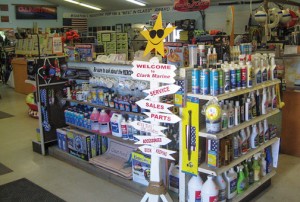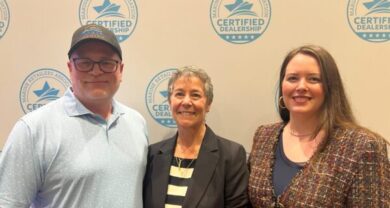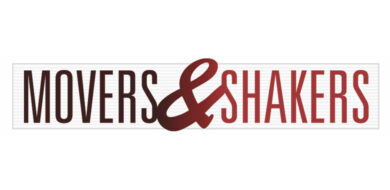2014 Best in Class: Best Service Department

2014 Best Service Department:
Clark Marine
Manchester, Maine
When Rob Brown measures the success of the service department at Clark Marine, efficiency is only part of what he looks at, because that number can hide bigger problems.
“I am big on employee efficiency, the comparison between flat rate and actual time, though I am bigger on employee proficiency – the comparison between hours paid and hours billed,” Brown said. “If a technician completes a two-hour flat rate job in two hours his efficiency rating is 100 percent – Monster! If it’s the only thing he accomplishes in the eight-hour day, though, not so monster! A 25 percent proficiency rating is too low.”
The goal for Clark Marine is for the senior technicians to have an annual proficiency rate of 60 percent, with junior techs in the mid-40s. That takes into account the five subpar months of available hours during Maine’s long offseason.
 “During employee evaluations I talk one on one with each person in my service operation about their performance over the previous year,” Brown said. “Using the proficiency reports … we are able to set realistic goals for the coming year and attach financial performance incentives based on correct proficiency increases.”
“During employee evaluations I talk one on one with each person in my service operation about their performance over the previous year,” Brown said. “Using the proficiency reports … we are able to set realistic goals for the coming year and attach financial performance incentives based on correct proficiency increases.”
In-season, the technicians averaged a 100.72 percent efficiency rating and 54.59 proficiency rating in 2013. As Brown points out to the service team, small changes can make big differences in the bottom line.
“If we could increase our team proficiency by just 2 percentage points this would earn the $50,000 we have guaranteed in staff raises for 2014,” he said. “We need to average just 12 more billed hours per week through the year to get there.”
With 22 service employees spread across two locations, it’s important to not just keep a handle on the numbers but also the process and schedule.
Clark has a detailed process map that clearly lays out the service department process. The process maps are included in the company’s employee handbook, and new employees are expected to read and understand the processes before they are set to work on their own. Additionally, new hires spend 10 to 15 days shadowing an established team member when they start.
“When things do not go pretty much to plan we can usually go back and dissect our actions and see where we did not follow guidelines,” Brown said. “I am fully convinced that it is not just our written processes that set us apart from our competitors – it is more so that we actually follow the processes to the letter.”
To better manage workflow, Clark Marine relies on a detailed schedule that Brown refers to as the “company Bible.”
“Better than 95 percent of the service work we perform whether it be from over the counter services or internal repairs and rigging is scheduled,” he said. “Rigid as it sounds we allow very few drop offs; we will accept them but not before trying to have the customer drop off at a specific time.”
Each repair is assigned to a particular service technician when the appointment is made. Service managers have the responsibility to communicate with both the technician and the customer throughout the service process providing instruction, quotes and acknowledgement of completion, as well as for checking the quality of services rendered.
Communication from the service managers to the techs is an important part of Clark’s success. Every afternoon the service managers make the rounds to each technician listing out with them what their next full day’s schedule will include.
Before employees leave for the day, all boats that are on the property are staged or a workstation is opened up for the incoming appointment boats. Parts are pulled and the repair orders are ready awaiting any further customer comments.
One of the biggest challenges of Maine’s long winters is keeping the employees working while at the same time not starting the year in a financial hole. With that in mind, Clark focused on selling billed labor for the winter by capitalizing on the 500 boats it stores and 350 it winterizes every year.
As technicians were filling in condition reports they took more complete notes especially on canvas and appearance issues. All suggested repairs were placed on their own repair order and systematically were followed up on. Each boat in storage was positioned accordingly so that it could be accessed for work during the winter months. Each over-the-counter boat included the estimate along with the winterization bill and upon pick up the service team would talk with the customer about possibly performing the repairs over the winter.
Clark offered a discounted labor rate as long as the customer accepted the estimate within 30 days, in order to avoid work being pushed to the busy spring.
“We sold out the canvas department labor for four months. We kept our entire staff employed full time with no reduction in hours for the winter,” Brown said. “When our competitors were cutting hours or laying off their employees we kept everyone working at full rate full time. No one on staff took a winter financial hit.”






Bravo to team Clark, you practice all that I preach!
Keep raising the bar and proving that even a dealership that faces Maine’s harsh winters can be proactive and profitable!!
Although this is my first encounter with the Clark team, it’s not my first time dealing with repairs and service on my boat. Team Clark has taken on the task of fixing my boat so it does what it should. After coming from another service person who always had an excuse why he needed more time, even though he had my boat since May and it’s now August. So far Team Clark has kept me in the loop about what was going on and what my options where in regards to service and parts, and what they found to be wrong. They are very professional with all that they have done so far and get the job done when they say they will. My boats not done yet but parts are on the way and I am very excited to have a quality team working on it.